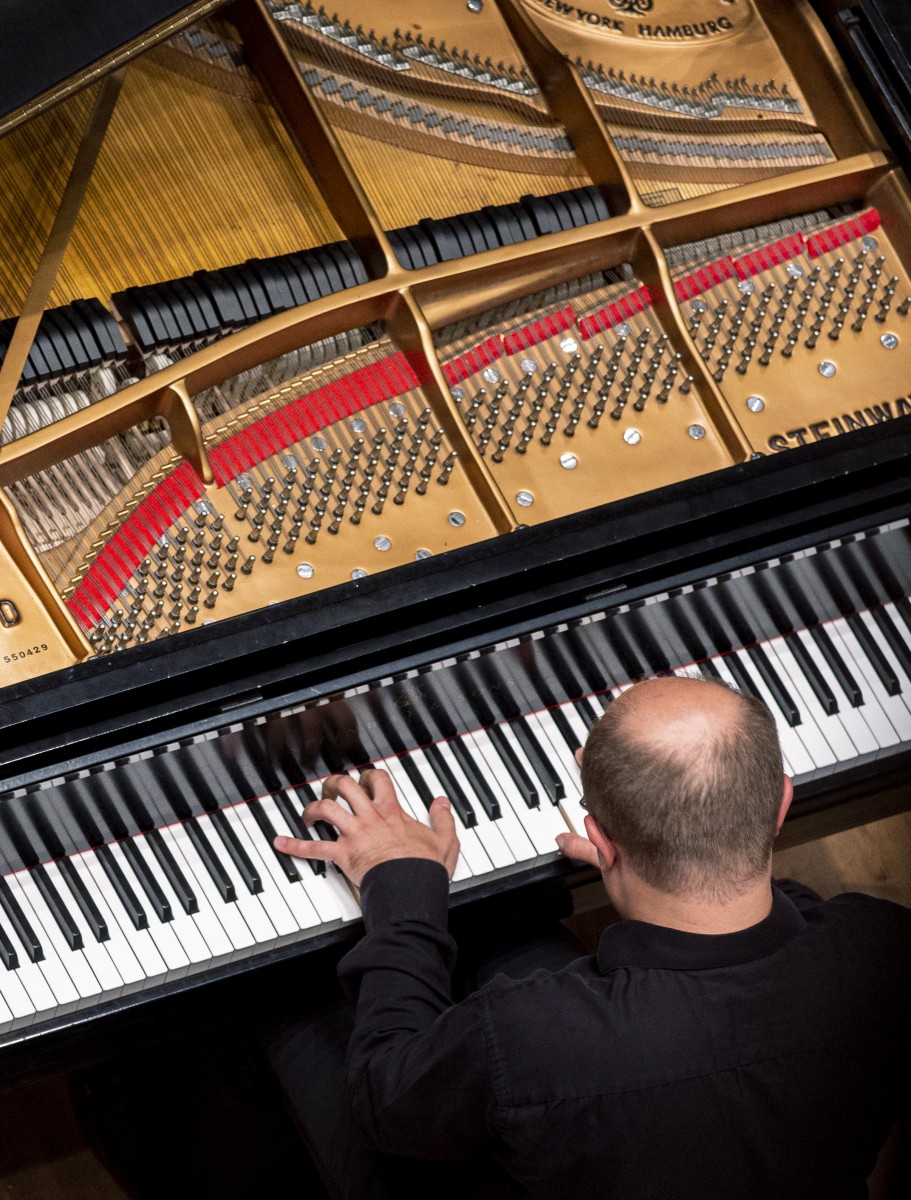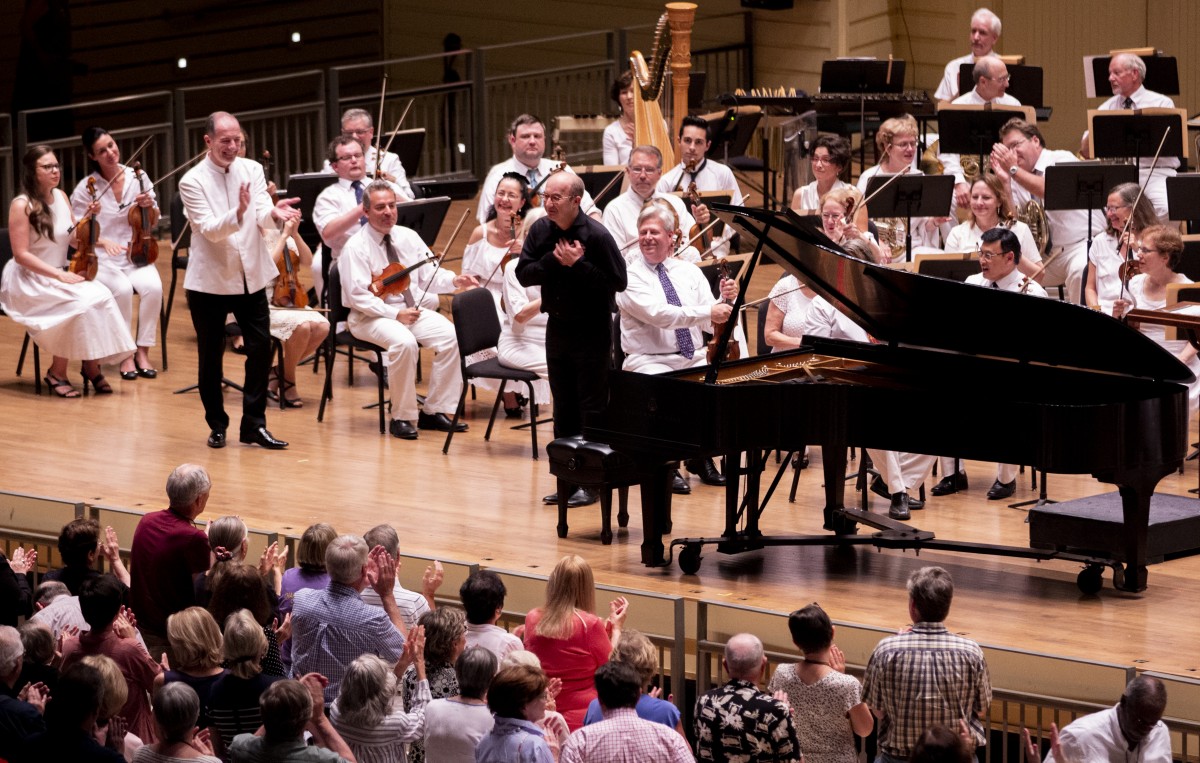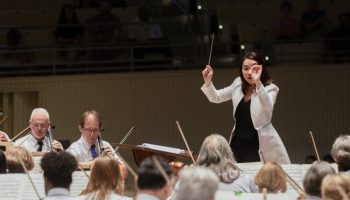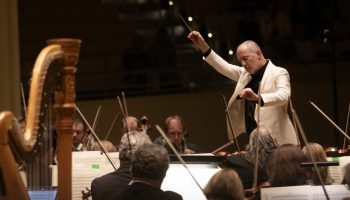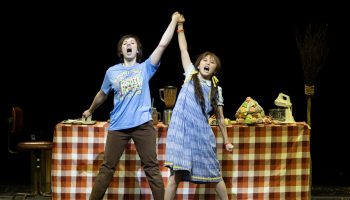Review by Johanna Keller:
The 90th season of the Chautauqua Symphony Orchestra opened with heavenly performances of three works that, in various ways, revolved around the theme of Hell.
Conductor Rossen Milanov, beginning his fifth season as music director, chose Peter Ilyich Tchaikovsky’s Francesca da Rimini, Symphonic Fantasy after Dante, Op. 32, as his challenging opener, which immediately plunges the listener into darkness and the swirling, stormy sufferings of the underworld. Programming it as an opener was a bold move, since the slashing strings and eddying woodwinds allow no time for orchestra players to warm up — welcome to Hades.
Doomed lovers abound in literature and myth: think of Orpheus and Eurydice, Tristan and Iseult, Romeo and Juliet. Once just as well-known, the story of Francesca’s illicit love affair with her brother-in-law Paolo inspired numerous operas, including one by Sergei Rachmaninoff. The tale comes from Dante Alighieri’s epic “The Divine Comedy,” and there are no more beloved passages than those of the fifth canto of The Inferno, when the author Dante reaches the second ring of Hell. There, raging winds eternally buffet those who committed the sin of lust. In the midst of this storm, Francesca tenderly recounts how she and Paolo fell in love. Rendered in Dante’s delicately rhymed three-line stanzas (terza rima), Francesca’s story so moves Dante that when she finishes speaking, he writes that he faints from emotion.
Tchaikovsky’s 1876 fantasy on the Francesca theme alternates lyrical moments (props to the soaring phrasing by Chautauqua’s principal clarinetist Eli Eban) with thunderous tutti passages that depict the netherworld’s storms as well as the storms of sexual passion. Milanov drew on his enormous range of communicative gestures to pull out of the orchestra sweeping, singing phrases that built to a final climactic accelerando, and was answered by cheers from the audience. It was an auspicious beginning.
In the world of classical music, one of the most bizarre characters has to be violinist and composer, Nicolò Paganini (1782-1840), who played so brilliantly, he was rumored to have sold his soul to Satan. Paganini’s abilities on the violin — he also played the viola and guitar — were the stuff of legend, and he invented new ways of playing the instrument in his 24 Caprices that bedevil violinists to the present day. A tall, spectrally thin man, Paganini brought some audience members to shrieks with the physicality of his performances — think of Mick Jagger crossed with a young Elvis. In recent years, much has been written about the theory — which was referenced by Chautauqua’s resident musicologist David Levy in his excellent pre-concert lecture in the Hall of Christ — that Paganini had Marfan syndrome, and was double-jointed, accounting perhaps for some of his unusual dexterity.
Pianist Alexander Gavrylyuk took the stage for the fiendish, knuckle-breaking challenge of Rachmaninoff’s Rhapsody on a Theme of Paganini for Piano and Orchestra, Op. 43. Like Paganini, Rachmaninoff was a virtuoso performer, one of the great pianists of his century, so the keyboard technical challenges are abundant.
Gavrylyuk, who also serves as the Heintzelman Family Artistic Advisor and artist-in-residence for the Chautauqua School of Music Piano Program, delivered an electrifying interpretation with propulsive energy, cascades of notes transformed into sheer veils and gigantic Rachmaninoff chords that demand not only power but astute voicing. Better known outside of the United States, Gavrylyuk is on track for a stellar international career. Milanov kept the orchestra with him every step of the way, with plaintive solo violin work by acting concertmaster Vahn Armstrong.
Theme and variations are playful forms that show off the inventiveness of the composer. Early on, Rachmaninoff gives us a wink with hints of the Dies Irae — the often-quoted Gregorian chant that summons up images of death — to allude to Paganini’s demonic reputation.
Most famously in this work, at the apogee comes a most exquisite tune (I hear it in my mind’s ear as I write these words), a tune you would recognize. Tchaikovsky invented it, or discovered it, when he inverted Paganini’s theme and recognized it as a stunner. He treats it with a full-out sobbing rendition in the orchestra and then lets the piano caress it alone, just once, before the next variation begins. A lesser composer than Tchaikovsky would have brought the hit tune back at the end, but instead, it gains all the more poignancy for its brief but spectacular, singular appearance. Milanov drove his orchestra through the final variations that pound out the Dies Irae to the shattering conclusion, with the tiny tail of a piano flourish at the very end that always brings a laugh from the audience. Wit indeed. The loudest cheering of the night came for Gavrylyuk, a favorite at Chautauqua.
At intermission, some of the audience filtered away, unfortunately missing one of the rare opportunities to hear Dmitri Shostakovich’s Sixth Symphony from 1939. On the surface, this extremely unusual work has nothing whatsoever to do with Hell. There are no infernos, no hellish storms, no Dies Irae, and no souls sold to the devil — or are there?
Throughout his early life, Shostakovich (1906-1975) suffered from the vicissitudes of the dictator Stalin, living in an atmosphere of terror that most of us (I hope) have never experienced and can scarcely imagine. Unfortunately for Russian artists, Stalin took a great interest in them and their work. A word misspoken or misunderstood, a work of art deemed “too formal” or “not socialist realism,” could land one on the wrong side of history — or in the gulag. Or shot. The midnight knock at the door: Such things happened under Stalin, when it is estimated that more than a million Russians died in the gulags over 20 years; others died uncounted.
In 1934, Shostakovich had written an opera, Lady Macbeth of the Mtsensk District, that got him denounced by the Communist Party after an anonymous article appeared, perhaps written by Stalin himself. Shostakovich managed to redeem himself by composing, as his Fifth Symphony, a triumphant celebration of Soviet might. For his next symphony, he announced he would use poet Vladimir Mayakovsky’s paean, “Vladimir Ilyich Lenin,” and would convey “spring, joy, youth.” On the surface, this plan sounded like a surefire way to further ingratiate himself to Stalin. But when it comes to Shostakovich — his music or his life story — the surface is always a betrayal.
Mayakovsky had been one of the most famous poets in Russia and tapped the young Shostakovich years before to provide some stage music. But the poet had his own political problems. He was a futurist: Stalin disapproved. The poet died by suicide in 1930, and afterward, and still to this day, there are arguments that it was actually an assassination.
So, for whatever reason, the symphony Shostakovich wrote was not as announced. There is no Mayakovsky poem, no chorus. Instead, it begins with a Largo that takes up more than half the work. Somber and based on minor third and diminished seventh motifs, its thickly orchestrated passages give way to moments when one instrument — piccolo, flute or English horn — are virtually isolated. It is impossible to hear this effect without thinking of the way Stalinist terror could isolate and silence individual voices. The composer finishes with two shorter movements: an Allegro and then a Presto that, for all their energy and verve, are underpinned with the bitter irony that mark this great composer’s work. There are various kinds of hell — and perhaps this symphony describes one of them.
Milanov and the orchestra members turned in an unforgettable performance — the strings bearing down on the lacerating passages, outstanding solo turns from the woodwinds and brass and percussion providing what sometimes sounded like an alarm. Milanov whipped up a galloping finale that propelled the audience to its feet and, after a sustained ovation, out into the safe and peaceful darkness of the charming streets of Chautauqua.
Johanna Keller received the ASCAP/Deems Taylor Award for her essays on music in The New York Times. She writes for Opera and The Hopkins Review and teaches journalism at Syracuse University’s Newhouse School.


